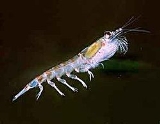
Antarctic krill
Encyclopedia
Antarctic krill, Euphausia superba, is a species
of krill
found in the Antarctic waters of the Southern Ocean
. It is a shrimp
-like crustacean
that lives in large schools, called swarm
s, sometimes reaching densities of 10,000–30,000 individual animals per cubic metre. It feeds directly on minute phytoplankton
, thereby using the primary production
energy
that the phytoplankton originally derived from the sun in order to sustain their pelagic (open ocean
) life cycle
. It grows to a length of 6 centimetres (2.4 in), weighs up to 2 gram (0.0705479242102239 oz), and can live for up to six years. It is a key species in the Antarctic ecosystem
and is, in terms of biomass
, probably the most abundant animal species on the planet (approximately 500 million tonnes).
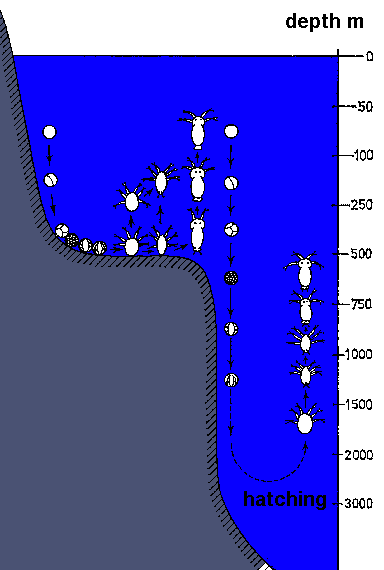 The main spawning
The main spawning
season of Antarctic krill is from January to March, both above the continental shelf
and also in the upper region of deep sea oceanic areas. In the typical way of all krill, the male attaches a spermatophore
to the genital opening of the female. For this purpose, the first pleopods (legs attached to the abdomen) of the male are constructed as mating tools. Females lay 6,000–10,000 eggs
at one time. They are fertilised
as they pass out of the genital opening.
According to the classical hypothesis of Marr, derived from the results of the expedition of the famous British research vessel RRS Discovery
, egg development then proceeds as follows: gastrulation
(development of egg into embryo) sets in during the descent of the 0.6 mm (0.0236220472440945 in) eggs on the shelf at the bottom, in oceanic areas in depths around 2000–3000 m (6,561.7–9,842.5 ). The egg hatches as a nauplius larva; once this has moulted into a metanauplius, the young animal starts migrating towards the surface in a migration known as developmental ascent.
The next two larval stages, termed second nauplius and metanauplius, still do not eat but are nourished by the remaining yolk. After three weeks, the young krill has finished the ascent. They can appear in enormous numbers counting 2 per litre in 60 m (196.9 ft) water depth. Growing larger, additional larval stages follow (second and third calyptopis, first to sixth furcilia). They are characterised by increasing development of the additional legs, the compound eyes and the setae (bristles). At 15 mm (0.590551181102362 in), the juvenile krill resembles the habitus of the adults. Krill reach maturity after two to three years. Like all crustacean
s, krill must moult
in order to grow. Approximately every 13 to 20 days, krill shed their chitin
ous exoskeleton
and leave it behind as exuvia
.
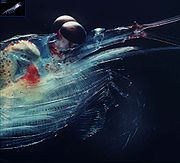
– especially very small diatom
s (20 μm
), which it filters from the water with a feeding basket. The glass-like shells of the diatom
s are cracked in the "gastric mill" and then digested in the hepatopancreas
. The krill can also catch and eat copepod
s, amphipods and other small zooplankton
. The gut forms a straight tube; its digestive efficiency is not very high and therefore a lot of carbon
is still present in the feces
.
In aquaria
, krill have been observed to eat each other. When they are not fed in aquaria, they shrink in size after moulting
, which is exceptional for animals the size of krill. It is likely that this is an adaptation
to the seasonality of their food supply, which is limited in the dark winter months under the ice. However, the animal's compound eyes do not shrink, and so the ratio between eye size and body length has thus been found to be a reliable indicator of starvation.
cells, which no other animal of krill size can do. This is accomplished through filter feeding, using the krill's highly developed front legs, providing for an efficient filtering apparatus: the six thoracopods (legs attached to the thorax
) form a very effective "feeding basket" used to collect phytoplankton from the open water. In the finest areas the openings in this basket are only 1 μm in diameter. In lower food concentrations, the feeding basket is pushed through the water for over half a metre in an opened position, and then the algae are combed to the mouth opening with special setae (bristles) on the inner side of the thoracopods.
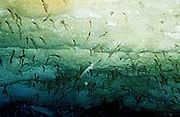
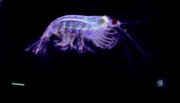 Krill are thought to undergo between one and three vertical migrations from mixed surface waters to depth each day. The krill is a very untidy feeder, and it often spits out aggregates of phytoplankton
Krill are thought to undergo between one and three vertical migrations from mixed surface waters to depth each day. The krill is a very untidy feeder, and it often spits out aggregates of phytoplankton
(spit balls) containing thousands of cells sticking together. It also produces fecal strings that still contain significant amounts of carbon
and the glass
shells of the diatom
s. Both are heavy and sink very fast into the abyss. This process is called the biological pump
. As the waters around Antarctica are very deep (2000 metre), they act as a carbon dioxide sink
: this process exports large quantities of carbon (fixed carbon dioxide
, CO2) from the biosphere and sequesters it for about 1,000 years.
If the phytoplankton is consumed by other components of the pelagic ecosystem, most of the carbon remains in the upper strata. There is speculation that this process is one of the largest biofeedback mechanisms of the planet, maybe the most sizable of all, driven by a gigantic biomass. Still more research is needed to quantify the Southern Ocean ecosystem.
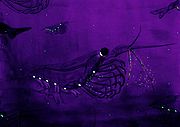 Krill are often referred to as light-shrimp because they can emit light, produced by bioluminescent
Krill are often referred to as light-shrimp because they can emit light, produced by bioluminescent
organs. These organs are located on various parts of the individual krill's body: one pair of organs at the eyestalk
(cf. the image of the head above), another pair on the hips of the second and seventh thoracopods, and singular organs on the four pleonsternites. These light organs emit a yellow-green light periodically, for up to 2–3 s. They are considered so highly developed that they can be compared with a torchlight: a concave reflector in the back of the organ and a lens in the front guide the light produced, and the whole organ can be rotated by muscles. The function of these lights is not yet fully understood; some hypotheses have suggested they serve to compensate the krill's shadow so that they are not visible to predators from below; other speculations maintain that they play a significant role in mating
or schooling
at night.
The krill's bioluminescent organs contain several fluorescent substances. The major component has a maximum fluorescence
at an excitation of 355 nm
and emission of 510 nm.

. Krill can reach speeds of over 0.6 m/s. The trigger time to optical stimulus
is, despite the low temperatures, only 55 ms
.
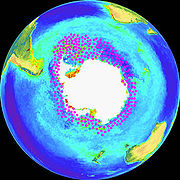 Antarctic krill has a circumpolar distribution, being found throughout the Southern Ocean
Antarctic krill has a circumpolar distribution, being found throughout the Southern Ocean
, and as far north as the Antarctic Convergence
. Isolated populations of larvae may occasionally be carried much further north, with records from as far north as Isla Guarello in Chile
, at 50° south
. At the Antarctic Convergence, the cold Antarctic surface water submerges below the warmer subantarctic
waters. This front runs roughly at 55° south
; from there to the continent, the Southern Ocean covers 32 million square kilometres. This is 65 times the size of the North Sea
. In the winter season, more than three quarters of this area become covered by ice, whereas 24000000 square kilometres (9,266,451.8 sq mi) become ice free in summer. The water temperature fluctuates at −1.3 C.
The waters of the Southern Ocean form a system of currents. Whenever there is a West Wind Drift
, the surface strata travels around Antarctica in an easterly direction. Near the continent, the East Wind Drift runs counterclockwise. At the front between both, large eddies
develop, for example, in the Weddell Sea
. The krill schools drift with these water masses, to establish one single stock all around Antarctica, with gene exchange over the whole area. Currently, there is little knowledge of the precise migration patterns since individual krill cannot yet be tagged to track their movements.
of the Antarctica ecosystem, and provides an important food source for whale
s, seals, Leopard Seal
s, fur seal
s, Crabeater Seal
s, squid
, icefish
, penguin
s, albatross
es and many other species of bird
s. Crabeater seals have even developed special teeth as an adaptation to catch this abundant food source: its unusual multilobed teeth enable this species to sieve krill from the water. Its dentition looks like a perfect strainer, but how it operates in detail is still unknown. Crabeaters are the most abundant seal in the world; 98% of their diet is made up of E. superba. These seals consume over 63 million tonne
s of krill each year. Leopard seal
s have developed similar teeth (45% krill in diet). All seals consume 63–130 million tonnes, all whales 34–43 million tonnes, birds 15–20 million tonnes, squid 30–100 million tonnes, and fish 10–20 million tonnes, adding up to 152–313 million tonnes of krill consumption each year.
The size step between krill and its prey is unusually large: generally it takes three or four steps from the 20 μm small phytoplankton
cells to a krill-sized organism (via small copepod
s, large copepods, mysids to 5 cm fish
). The next size step in the food chain
to the whale
s is also enormous, a phenomenon
only found in the Antarctic ecosystem. E. superba lives only in the Southern Ocean. In the North Atlantic, Meganyctiphanes norvegica and in the Pacific, Euphausia pacifica are the dominant species.
of Antarctic krill is estimated to be 125 to 725 million tonne
s. The reason Antarctic krill are able to build up such a high biomass and production is that the waters around the icy Antarctic continent harbour one of the largest plankton
assemblages in the world, possibly the largest. The ocean is filled with phytoplankton
; as the water rises from the depths to the light-flooded surface, it brings nutrient
s from all of the world's oceans back into the photic zone
where they are once again available to living organisms.
Thus primary production
– the conversion of sunlight into organic biomass, the foundation of the food chain – has an annual carbon fixation of 1–2 g/m2 in the open ocean. Close to the ice it can reach 30–50 g/m2. These values are not outstandingly high, compared to very productive areas like the North Sea
or upwelling
regions, but the area over which it takes place is enormous, even compared to other large primary producers such as rainforest
s. In addition, during the Austral summer there are many hours of daylight to fuel the process. All of these factors make the plankton and the krill a critical part of the planet's ecocycle.
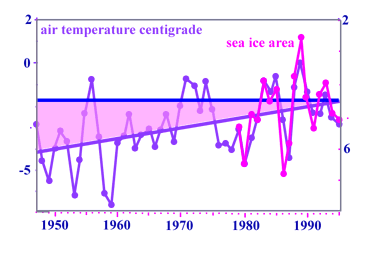 A possible decline in Antarctic krill biomass may have been caused by the reduction of the pack ice zone due to global warming
A possible decline in Antarctic krill biomass may have been caused by the reduction of the pack ice zone due to global warming
. Antarctic krill, especially in the early stages of development, seem to need the pack ice structures in order to have a fair chance of survival. The pack ice provides natural cave-like features which the krill uses to evade their predators. In the years of low pack ice conditions the krill tend to give way to salp
s, a barrel-shaped free-floating filter feeder
that also grazes on plankton.
caused by increasing levels of carbon dioxide. Krill exoskeleton contains carbonate, which is susceptible to dissolution under low pH
conditions. It has already been shown that increased carbon dioxide can disrupt the development of krill eggs and even prevent the juvenile krill from hatching. The further effects of ocean acidification on the krill life cycle however remains unclear but scientists fear that it could significantly impact on its distribution, abundance and survival.
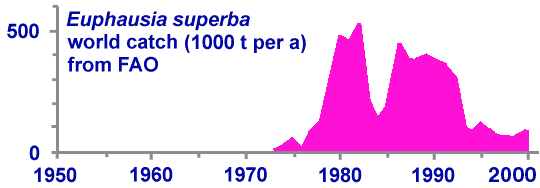 The fishery of Antarctic krill is on the order of 100,000 tonnes per year. The major catching nations are South Korea
The fishery of Antarctic krill is on the order of 100,000 tonnes per year. The major catching nations are South Korea
, Norway
, Japan
and Poland
. The products are used as animal food and fish bait. Krill fisheries are difficult to operate in two important respects. First, a krill net needs to have very fine meshes, producing a very high drag
, which generates a bow wave
that deflects the krill to the sides. Second, fine meshes tend to clog very fast.
Yet another problem is bringing the krill catch on board. When the full net is hauled out of the water, the organisms compress each other, resulting in great loss of the krill's liquids. Experiments have been carried out to pump krill, while still in water, through a large tube on board. Special krill nets also are currently under development. The processing of the krill must be very rapid since the catch deteriorates within several hours. Its high protein and vitamin content makes krill quite suitable for both direct human consumption and the animal-feed industry.
(high nutrient, low carbon). The phenomenon is called the Antarctic Paradox, and occurs because iron
is missing. Relatively small injections of iron from research vessels trigger very large blooms, covering many miles. The hope is that such large scale exercises will draw down carbon dioxide
as compensation for the burning of fossil fuel
s.
Species
In biology, a species is one of the basic units of biological classification and a taxonomic rank. A species is often defined as a group of organisms capable of interbreeding and producing fertile offspring. While in many cases this definition is adequate, more precise or differing measures are...
of krill
Krill
Krill is the common name given to the order Euphausiacea of shrimp-like marine crustaceans. Also known as euphausiids, these small invertebrates are found in all oceans of the world...
found in the Antarctic waters of the Southern Ocean
Southern Ocean
The Southern Ocean comprises the southernmost waters of the World Ocean, generally taken to be south of 60°S latitude and encircling Antarctica. It is usually regarded as the fourth-largest of the five principal oceanic divisions...
. It is a shrimp
Shrimp
Shrimp are swimming, decapod crustaceans classified in the infraorder Caridea, found widely around the world in both fresh and salt water. Adult shrimp are filter feeding benthic animals living close to the bottom. They can live in schools and can swim rapidly backwards. Shrimp are an important...
-like crustacean
Crustacean
Crustaceans form a very large group of arthropods, usually treated as a subphylum, which includes such familiar animals as crabs, lobsters, crayfish, shrimp, krill and barnacles. The 50,000 described species range in size from Stygotantulus stocki at , to the Japanese spider crab with a leg span...
that lives in large schools, called swarm
Swarm
Swarm behaviour, or swarming, is a collective behaviour exhibited by animals of similar size which aggregate together, perhaps milling about the same spot or perhaps moving en masse or migrating in some direction. As a term, swarming is applied particularly to insects, but can also be applied to...
s, sometimes reaching densities of 10,000–30,000 individual animals per cubic metre. It feeds directly on minute phytoplankton
Phytoplankton
Phytoplankton are the autotrophic component of the plankton community. The name comes from the Greek words φυτόν , meaning "plant", and πλαγκτός , meaning "wanderer" or "drifter". Most phytoplankton are too small to be individually seen with the unaided eye...
, thereby using the primary production
Primary production
400px|thumb|Global oceanic and terrestrial photoautotroph abundance, from September [[1997]] to August 2000. As an estimate of autotroph biomass, it is only a rough indicator of primary production potential, and not an actual estimate of it...
energy
Energy
In physics, energy is an indirectly observed quantity. It is often understood as the ability a physical system has to do work on other physical systems...
that the phytoplankton originally derived from the sun in order to sustain their pelagic (open ocean
Ocean
An ocean is a major body of saline water, and a principal component of the hydrosphere. Approximately 71% of the Earth's surface is covered by ocean, a continuous body of water that is customarily divided into several principal oceans and smaller seas.More than half of this area is over 3,000...
) life cycle
Biological life cycle
A life cycle is a period involving all different generations of a species succeeding each other through means of reproduction, whether through asexual reproduction or sexual reproduction...
. It grows to a length of 6 centimetres (2.4 in), weighs up to 2 gram (0.0705479242102239 oz), and can live for up to six years. It is a key species in the Antarctic ecosystem
Ecosystem
An ecosystem is a biological environment consisting of all the organisms living in a particular area, as well as all the nonliving , physical components of the environment with which the organisms interact, such as air, soil, water and sunlight....
and is, in terms of biomass
Biomass (ecology)
Biomass, in ecology, is the mass of living biological organisms in a given area or ecosystem at a given time. Biomass can refer to species biomass, which is the mass of one or more species, or to community biomass, which is the mass of all species in the community. It can include microorganisms,...
, probably the most abundant animal species on the planet (approximately 500 million tonnes).
Life cycle

Spawn (biology)
Spawn refers to the eggs and sperm released or deposited, usually into water, by aquatic animals. As a verb, spawn refers to the process of releasing the eggs and sperm, also called spawning...
season of Antarctic krill is from January to March, both above the continental shelf
Continental shelf
The continental shelf is the extended perimeter of each continent and associated coastal plain. Much of the shelf was exposed during glacial periods, but is now submerged under relatively shallow seas and gulfs, and was similarly submerged during other interglacial periods. The continental margin,...
and also in the upper region of deep sea oceanic areas. In the typical way of all krill, the male attaches a spermatophore
Spermatophore
A spermatophore or sperm ampulla is a capsule or mass created by males of various animal species, containing spermatozoa and transferred in entirety to the female's ovipore during copulation...
to the genital opening of the female. For this purpose, the first pleopods (legs attached to the abdomen) of the male are constructed as mating tools. Females lay 6,000–10,000 eggs
Egg (biology)
An egg is an organic vessel in which an embryo first begins to develop. In most birds, reptiles, insects, molluscs, fish, and monotremes, an egg is the zygote, resulting from fertilization of the ovum, which is expelled from the body and permitted to develop outside the body until the developing...
at one time. They are fertilised
Fertilisation
Fertilisation is the fusion of gametes to produce a new organism. In animals, the process involves the fusion of an ovum with a sperm, which eventually leads to the development of an embryo...
as they pass out of the genital opening.
According to the classical hypothesis of Marr, derived from the results of the expedition of the famous British research vessel RRS Discovery
RRS Discovery
The RRS Discovery was the last traditional wooden three-masted ship to be built in Britain. Designed for Antarctic research, she was launched in 1901. Her first mission was the British National Antarctic Expedition, carrying Robert Falcon Scott and Ernest Shackleton on their first, successful...
, egg development then proceeds as follows: gastrulation
Gastrulation
Gastrulation is a phase early in the embryonic development of most animals, during which the single-layered blastula is reorganized into a trilaminar structure known as the gastrula. These three germ layers are known as the ectoderm, mesoderm, and endoderm.Gastrulation takes place after cleavage...
(development of egg into embryo) sets in during the descent of the 0.6 mm (0.0236220472440945 in) eggs on the shelf at the bottom, in oceanic areas in depths around 2000–3000 m (6,561.7–9,842.5 ). The egg hatches as a nauplius larva; once this has moulted into a metanauplius, the young animal starts migrating towards the surface in a migration known as developmental ascent.
The next two larval stages, termed second nauplius and metanauplius, still do not eat but are nourished by the remaining yolk. After three weeks, the young krill has finished the ascent. They can appear in enormous numbers counting 2 per litre in 60 m (196.9 ft) water depth. Growing larger, additional larval stages follow (second and third calyptopis, first to sixth furcilia). They are characterised by increasing development of the additional legs, the compound eyes and the setae (bristles). At 15 mm (0.590551181102362 in), the juvenile krill resembles the habitus of the adults. Krill reach maturity after two to three years. Like all crustacean
Crustacean
Crustaceans form a very large group of arthropods, usually treated as a subphylum, which includes such familiar animals as crabs, lobsters, crayfish, shrimp, krill and barnacles. The 50,000 described species range in size from Stygotantulus stocki at , to the Japanese spider crab with a leg span...
s, krill must moult
Ecdysis
Ecdysis is the moulting of the cuticula in many invertebrates. This process of moulting is the defining feature of the clade Ecdysozoa, comprising the arthropods, nematodes, velvet worms, horsehair worms, rotifers, tardigrades and Cephalorhyncha...
in order to grow. Approximately every 13 to 20 days, krill shed their chitin
Chitin
Chitin n is a long-chain polymer of a N-acetylglucosamine, a derivative of glucose, and is found in many places throughout the natural world...
ous exoskeleton
Exoskeleton
An exoskeleton is the external skeleton that supports and protects an animal's body, in contrast to the internal skeleton of, for example, a human. In popular usage, some of the larger kinds of exoskeletons are known as "shells". Examples of exoskeleton animals include insects such as grasshoppers...
and leave it behind as exuvia
Exuvia
Exuviae is a term used in biology to describe the remains of an exoskeleton and related structures that are left after ecdysozoans have moulted...
.

Food
The gut of E. superba can often be seen shining green through the animal's transparent skin, an indication that this species feeds predominantly on phytoplanktonPhytoplankton
Phytoplankton are the autotrophic component of the plankton community. The name comes from the Greek words φυτόν , meaning "plant", and πλαγκτός , meaning "wanderer" or "drifter". Most phytoplankton are too small to be individually seen with the unaided eye...
– especially very small diatom
Diatom
Diatoms are a major group of algae, and are one of the most common types of phytoplankton. Most diatoms are unicellular, although they can exist as colonies in the shape of filaments or ribbons , fans , zigzags , or stellate colonies . Diatoms are producers within the food chain...
s (20 μm
Micrometre
A micrometer , is by definition 1×10-6 of a meter .In plain English, it means one-millionth of a meter . Its unit symbol in the International System of Units is μm...
), which it filters from the water with a feeding basket. The glass-like shells of the diatom
Diatom
Diatoms are a major group of algae, and are one of the most common types of phytoplankton. Most diatoms are unicellular, although they can exist as colonies in the shape of filaments or ribbons , fans , zigzags , or stellate colonies . Diatoms are producers within the food chain...
s are cracked in the "gastric mill" and then digested in the hepatopancreas
Hepatopancreas
The hepatopancreas, digestive gland or midgut gland is an organ of the digestive tract of arthropods, molluscs and fish. It provides the functions which in mammals are provided separately by the liver and pancreas, including the production of digestive enzymes, and absorption of digested...
. The krill can also catch and eat copepod
Copepod
Copepods are a group of small crustaceans found in the sea and nearly every freshwater habitat. Some species are planktonic , some are benthic , and some continental species may live in limno-terrestrial habitats and other wet terrestrial places, such as swamps, under leaf fall in wet forests,...
s, amphipods and other small zooplankton
Zooplankton
Zooplankton are heterotrophic plankton. Plankton are organisms drifting in oceans, seas, and bodies of fresh water. The word "zooplankton" is derived from the Greek zoon , meaning "animal", and , meaning "wanderer" or "drifter"...
. The gut forms a straight tube; its digestive efficiency is not very high and therefore a lot of carbon
Carbon
Carbon is the chemical element with symbol C and atomic number 6. As a member of group 14 on the periodic table, it is nonmetallic and tetravalent—making four electrons available to form covalent chemical bonds...
is still present in the feces
Feces
Feces, faeces, or fæces is a waste product from an animal's digestive tract expelled through the anus or cloaca during defecation.-Etymology:...
.
In aquaria
Aquarium
An aquarium is a vivarium consisting of at least one transparent side in which water-dwelling plants or animals are kept. Fishkeepers use aquaria to keep fish, invertebrates, amphibians, marine mammals, turtles, and aquatic plants...
, krill have been observed to eat each other. When they are not fed in aquaria, they shrink in size after moulting
Ecdysis
Ecdysis is the moulting of the cuticula in many invertebrates. This process of moulting is the defining feature of the clade Ecdysozoa, comprising the arthropods, nematodes, velvet worms, horsehair worms, rotifers, tardigrades and Cephalorhyncha...
, which is exceptional for animals the size of krill. It is likely that this is an adaptation
Adaptation
An adaptation in biology is a trait with a current functional role in the life history of an organism that is maintained and evolved by means of natural selection. An adaptation refers to both the current state of being adapted and to the dynamic evolutionary process that leads to the adaptation....
to the seasonality of their food supply, which is limited in the dark winter months under the ice. However, the animal's compound eyes do not shrink, and so the ratio between eye size and body length has thus been found to be a reliable indicator of starvation.
Filter feeding
Antarctic krill directly use the minute phytoplanktonPhytoplankton
Phytoplankton are the autotrophic component of the plankton community. The name comes from the Greek words φυτόν , meaning "plant", and πλαγκτός , meaning "wanderer" or "drifter". Most phytoplankton are too small to be individually seen with the unaided eye...
cells, which no other animal of krill size can do. This is accomplished through filter feeding, using the krill's highly developed front legs, providing for an efficient filtering apparatus: the six thoracopods (legs attached to the thorax
Thorax
The thorax is a division of an animal's body that lies between the head and the abdomen.-In tetrapods:...
) form a very effective "feeding basket" used to collect phytoplankton from the open water. In the finest areas the openings in this basket are only 1 μm in diameter. In lower food concentrations, the feeding basket is pushed through the water for over half a metre in an opened position, and then the algae are combed to the mouth opening with special setae (bristles) on the inner side of the thoracopods.

Ice-algae raking
Antarctic krill can scrape off the green lawn of ice-algae from the underside of the pack ice. Krill have developed special rows of rake-like setae at the tips of the thoracopods, and graze the ice in a zig-zag fashion. One krill can clear an area of a square foot in about 10 minutes (1.5 cm2/s). It is relatively new knowledge that the film of ice algae is very well developed over vast areas, often containing much more carbon than the whole water column below. Krill find an extensive energy source here, especially in the spring.Biological pump and carbon sequestration

Phytoplankton
Phytoplankton are the autotrophic component of the plankton community. The name comes from the Greek words φυτόν , meaning "plant", and πλαγκτός , meaning "wanderer" or "drifter". Most phytoplankton are too small to be individually seen with the unaided eye...
(spit balls) containing thousands of cells sticking together. It also produces fecal strings that still contain significant amounts of carbon
Carbon
Carbon is the chemical element with symbol C and atomic number 6. As a member of group 14 on the periodic table, it is nonmetallic and tetravalent—making four electrons available to form covalent chemical bonds...
and the glass
Glass
Glass is an amorphous solid material. Glasses are typically brittle and optically transparent.The most familiar type of glass, used for centuries in windows and drinking vessels, is soda-lime glass, composed of about 75% silica plus Na2O, CaO, and several minor additives...
shells of the diatom
Diatom
Diatoms are a major group of algae, and are one of the most common types of phytoplankton. Most diatoms are unicellular, although they can exist as colonies in the shape of filaments or ribbons , fans , zigzags , or stellate colonies . Diatoms are producers within the food chain...
s. Both are heavy and sink very fast into the abyss. This process is called the biological pump
Biological pump
In oceanic biogeochemistry, the biological pump is the sum of a suite of biologically-mediated processes that transport carbon from the surface euphotic zone to the ocean's interior.-Overview:...
. As the waters around Antarctica are very deep (2000 metre), they act as a carbon dioxide sink
Carbon dioxide sink
A carbon sink is a natural or artificial reservoir that accumulates and stores some carbon-containing chemical compound for an indefinite period. The process by which carbon sinks remove carbon dioxide from the atmosphere is known as carbon sequestration...
: this process exports large quantities of carbon (fixed carbon dioxide
Carbon dioxide
Carbon dioxide is a naturally occurring chemical compound composed of two oxygen atoms covalently bonded to a single carbon atom...
, CO2) from the biosphere and sequesters it for about 1,000 years.
If the phytoplankton is consumed by other components of the pelagic ecosystem, most of the carbon remains in the upper strata. There is speculation that this process is one of the largest biofeedback mechanisms of the planet, maybe the most sizable of all, driven by a gigantic biomass. Still more research is needed to quantify the Southern Ocean ecosystem.
Bioluminescence

Bioluminescence
Bioluminescence is the production and emission of light by a living organism. Its name is a hybrid word, originating from the Greek bios for "living" and the Latin lumen "light". Bioluminescence is a naturally occurring form of chemiluminescence where energy is released by a chemical reaction in...
organs. These organs are located on various parts of the individual krill's body: one pair of organs at the eyestalk
Eyestalk
In anatomy, an eyestalk is a protrusion that extends the eye away from the body, giving the eye a better field of view than if it were unextended. It is common in nature and in fiction....
(cf. the image of the head above), another pair on the hips of the second and seventh thoracopods, and singular organs on the four pleonsternites. These light organs emit a yellow-green light periodically, for up to 2–3 s. They are considered so highly developed that they can be compared with a torchlight: a concave reflector in the back of the organ and a lens in the front guide the light produced, and the whole organ can be rotated by muscles. The function of these lights is not yet fully understood; some hypotheses have suggested they serve to compensate the krill's shadow so that they are not visible to predators from below; other speculations maintain that they play a significant role in mating
Mating
In biology, mating is the pairing of opposite-sex or hermaphroditic organisms for copulation. In social animals, it also includes the raising of their offspring. Copulation is the union of the sex organs of two sexually reproducing animals for insemination and subsequent internal fertilization...
or schooling
Shoaling and schooling
In biology, any group of fish that stay together for social reasons are said to be shoaling , and if, in addition, the group is swimming in the same direction in a coordinated manner, they are said to be schooling . In common usage, the terms are sometimes used rather loosely...
at night.
The krill's bioluminescent organs contain several fluorescent substances. The major component has a maximum fluorescence
Fluorescence
Fluorescence is the emission of light by a substance that has absorbed light or other electromagnetic radiation of a different wavelength. It is a form of luminescence. In most cases, emitted light has a longer wavelength, and therefore lower energy, than the absorbed radiation...
at an excitation of 355 nm
Nanometre
A nanometre is a unit of length in the metric system, equal to one billionth of a metre. The name combines the SI prefix nano- with the parent unit name metre .The nanometre is often used to express dimensions on the atomic scale: the diameter...
and emission of 510 nm.

Escape reaction
Krill use an escape reaction to evade predators, swimming backwards very quickly by flipping their rear ends. This swimming pattern is also known as lobsteringCaridoid escape reaction
The Caridoid Escape Reaction, also known as lobstering or tail-flipping, refers to an innate escape mechanism in marine and freshwater crustaceans such as lobsters, krill, shrimp and crayfish....
. Krill can reach speeds of over 0.6 m/s. The trigger time to optical stimulus
Stimulus (physiology)
In physiology, a stimulus is a detectable change in the internal or external environment. The ability of an organism or organ to respond to external stimuli is called sensitivity....
is, despite the low temperatures, only 55 ms
Millisecond
A millisecond is a thousandth of a second.10 milliseconds are called a centisecond....
.
Geographical distribution

Southern Ocean
The Southern Ocean comprises the southernmost waters of the World Ocean, generally taken to be south of 60°S latitude and encircling Antarctica. It is usually regarded as the fourth-largest of the five principal oceanic divisions...
, and as far north as the Antarctic Convergence
Antarctic Convergence
The Antarctic Convergence is a curve continuously encircling Antarctica where cold, northward-flowing Antarctic waters meet the relatively warmer waters of the subantarctic. Antarctic waters predominantly sink beneath subantarctic waters, while associated zones of mixing and upwelling create a zone...
. Isolated populations of larvae may occasionally be carried much further north, with records from as far north as Isla Guarello in Chile
Chile
Chile ,officially the Republic of Chile , is a country in South America occupying a long, narrow coastal strip between the Andes mountains to the east and the Pacific Ocean to the west. It borders Peru to the north, Bolivia to the northeast, Argentina to the east, and the Drake Passage in the far...
, at 50° south
50th parallel south
The 50th parallel south is a circle of latitude that is 50 degrees south of the Earth's equatorial plane. It crosses the Atlantic Ocean, the Indian Ocean, the Pacific Ocean and South America....
. At the Antarctic Convergence, the cold Antarctic surface water submerges below the warmer subantarctic
Subantarctic
The Subantarctic is a region in the southern hemisphere, located immediately north of the Antarctic region. This translates roughly to a latitude of between 46° – 60° south of the Equator. The subantarctic region includes many islands in the southern parts of the Indian Ocean, Atlantic Ocean and...
waters. This front runs roughly at 55° south
55th parallel south
The 55th parallel south is a circle of latitude that is 55 degrees south of the Earth's equatorial plane. It crosses the Atlantic Ocean, the Indian Ocean, the Pacific Ocean and South America....
; from there to the continent, the Southern Ocean covers 32 million square kilometres. This is 65 times the size of the North Sea
North Sea
In the southwest, beyond the Straits of Dover, the North Sea becomes the English Channel connecting to the Atlantic Ocean. In the east, it connects to the Baltic Sea via the Skagerrak and Kattegat, narrow straits that separate Denmark from Norway and Sweden respectively...
. In the winter season, more than three quarters of this area become covered by ice, whereas 24000000 square kilometres (9,266,451.8 sq mi) become ice free in summer. The water temperature fluctuates at −1.3 C.
The waters of the Southern Ocean form a system of currents. Whenever there is a West Wind Drift
Antarctic Circumpolar Current
The Antarctic Circumpolar Current is an ocean current that flows from west to east around Antarctica. An alternative name for the ACC is the West Wind Drift. The ACC is the dominant circulation feature of the Southern Ocean and, at approximately 125 Sverdrups, the largest ocean current...
, the surface strata travels around Antarctica in an easterly direction. Near the continent, the East Wind Drift runs counterclockwise. At the front between both, large eddies
Eddy (fluid dynamics)
In fluid dynamics, an eddy is the swirling of a fluid and the reverse current created when the fluid flows past an obstacle. The moving fluid creates a space devoid of downstream-flowing fluid on the downstream side of the object...
develop, for example, in the Weddell Sea
Weddell Sea
The Weddell Sea is part of the Southern Ocean and contains the Weddell Gyre. Its land boundaries are defined by the bay formed from the coasts of Coats Land and the Antarctic Peninsula. The easternmost point is Cape Norvegia at Princess Martha Coast, Queen Maud Land. To the east of Cape Norvegia is...
. The krill schools drift with these water masses, to establish one single stock all around Antarctica, with gene exchange over the whole area. Currently, there is little knowledge of the precise migration patterns since individual krill cannot yet be tagged to track their movements.
Ecology
Antarctic krill is the keystone speciesKeystone species
A keystone species is a species that has a disproportionately large effect on its environment relative to its abundance. Such species play a critical role in maintaining the structure of an ecological community, affecting many other organisms in an ecosystem and helping to determine the types and...
of the Antarctica ecosystem, and provides an important food source for whale
Whale
Whale is the common name for various marine mammals of the order Cetacea. The term whale sometimes refers to all cetaceans, but more often it excludes dolphins and porpoises, which belong to suborder Odontoceti . This suborder also includes the sperm whale, killer whale, pilot whale, and beluga...
s, seals, Leopard Seal
Leopard Seal
The leopard seal , also referred to as the sea leopard, is the second largest species of seal in the Antarctic...
s, fur seal
Fur seal
Fur seals are any of nine species of pinnipeds in the Otariidae family. One species, the northern fur seal inhabits the North Pacific, while seven species in the Arctocephalus genus are found primarily in the Southern hemisphere...
s, Crabeater Seal
Crabeater Seal
The crabeater seal, Lobodon carcinophagus, is a true seal with a circumpolar distribution around the coast of Antarctica. They are medium to large-sized , relatively slender and pale-colored, found primarily on the free floating pack ice that extends seasonally out from the Antarctic coast, which...
s, squid
Squid
Squid are cephalopods of the order Teuthida, which comprises around 300 species. Like all other cephalopods, squid have a distinct head, bilateral symmetry, a mantle, and arms. Squid, like cuttlefish, have eight arms arranged in pairs and two, usually longer, tentacles...
, icefish
Notothenioidei
The Antarctic icefish belong to the perciform suborder Notothenioidei and are the largely endemic, dominant fish taxa in the cold continental shelf waters surrounding Antarctica. At present, the suborder includes 8 families with 43 genera and 122 species...
, penguin
Penguin
Penguins are a group of aquatic, flightless birds living almost exclusively in the southern hemisphere, especially in Antarctica. Highly adapted for life in the water, penguins have countershaded dark and white plumage, and their wings have become flippers...
s, albatross
Albatross
Albatrosses, of the biological family Diomedeidae, are large seabirds allied to the procellariids, storm-petrels and diving-petrels in the order Procellariiformes . They range widely in the Southern Ocean and the North Pacific...
es and many other species of bird
Bird
Birds are feathered, winged, bipedal, endothermic , egg-laying, vertebrate animals. Around 10,000 living species and 188 families makes them the most speciose class of tetrapod vertebrates. They inhabit ecosystems across the globe, from the Arctic to the Antarctic. Extant birds range in size from...
s. Crabeater seals have even developed special teeth as an adaptation to catch this abundant food source: its unusual multilobed teeth enable this species to sieve krill from the water. Its dentition looks like a perfect strainer, but how it operates in detail is still unknown. Crabeaters are the most abundant seal in the world; 98% of their diet is made up of E. superba. These seals consume over 63 million tonne
Tonne
The tonne, known as the metric ton in the US , often put pleonastically as "metric tonne" to avoid confusion with ton, is a metric system unit of mass equal to 1000 kilograms. The tonne is not an International System of Units unit, but is accepted for use with the SI...
s of krill each year. Leopard seal
Leopard Seal
The leopard seal , also referred to as the sea leopard, is the second largest species of seal in the Antarctic...
s have developed similar teeth (45% krill in diet). All seals consume 63–130 million tonnes, all whales 34–43 million tonnes, birds 15–20 million tonnes, squid 30–100 million tonnes, and fish 10–20 million tonnes, adding up to 152–313 million tonnes of krill consumption each year.
The size step between krill and its prey is unusually large: generally it takes three or four steps from the 20 μm small phytoplankton
Phytoplankton
Phytoplankton are the autotrophic component of the plankton community. The name comes from the Greek words φυτόν , meaning "plant", and πλαγκτός , meaning "wanderer" or "drifter". Most phytoplankton are too small to be individually seen with the unaided eye...
cells to a krill-sized organism (via small copepod
Copepod
Copepods are a group of small crustaceans found in the sea and nearly every freshwater habitat. Some species are planktonic , some are benthic , and some continental species may live in limno-terrestrial habitats and other wet terrestrial places, such as swamps, under leaf fall in wet forests,...
s, large copepods, mysids to 5 cm fish
Fish
Fish are a paraphyletic group of organisms that consist of all gill-bearing aquatic vertebrate animals that lack limbs with digits. Included in this definition are the living hagfish, lampreys, and cartilaginous and bony fish, as well as various extinct related groups...
). The next size step in the food chain
Food chain
A food web depicts feeding connections in an ecological community. Ecologists can broadly lump all life forms into one of two categories called trophic levels: 1) the autotrophs, and 2) the heterotrophs...
to the whale
Whale
Whale is the common name for various marine mammals of the order Cetacea. The term whale sometimes refers to all cetaceans, but more often it excludes dolphins and porpoises, which belong to suborder Odontoceti . This suborder also includes the sperm whale, killer whale, pilot whale, and beluga...
s is also enormous, a phenomenon
Phenomenon
A phenomenon , plural phenomena, is any observable occurrence. Phenomena are often, but not always, understood as 'appearances' or 'experiences'...
only found in the Antarctic ecosystem. E. superba lives only in the Southern Ocean. In the North Atlantic, Meganyctiphanes norvegica and in the Pacific, Euphausia pacifica are the dominant species.
Biomass and production
The biomassBiomass (ecology)
Biomass, in ecology, is the mass of living biological organisms in a given area or ecosystem at a given time. Biomass can refer to species biomass, which is the mass of one or more species, or to community biomass, which is the mass of all species in the community. It can include microorganisms,...
of Antarctic krill is estimated to be 125 to 725 million tonne
Tonne
The tonne, known as the metric ton in the US , often put pleonastically as "metric tonne" to avoid confusion with ton, is a metric system unit of mass equal to 1000 kilograms. The tonne is not an International System of Units unit, but is accepted for use with the SI...
s. The reason Antarctic krill are able to build up such a high biomass and production is that the waters around the icy Antarctic continent harbour one of the largest plankton
Plankton
Plankton are any drifting organisms that inhabit the pelagic zone of oceans, seas, or bodies of fresh water. That is, plankton are defined by their ecological niche rather than phylogenetic or taxonomic classification...
assemblages in the world, possibly the largest. The ocean is filled with phytoplankton
Phytoplankton
Phytoplankton are the autotrophic component of the plankton community. The name comes from the Greek words φυτόν , meaning "plant", and πλαγκτός , meaning "wanderer" or "drifter". Most phytoplankton are too small to be individually seen with the unaided eye...
; as the water rises from the depths to the light-flooded surface, it brings nutrient
Nutrient
A nutrient is a chemical that an organism needs to live and grow or a substance used in an organism's metabolism which must be taken in from its environment. They are used to build and repair tissues, regulate body processes and are converted to and used as energy...
s from all of the world's oceans back into the photic zone
Photic zone
The photic zone or euphotic zone is the depth of the water in a lake or ocean that is exposed to sufficient sunlight for photosynthesis to occur...
where they are once again available to living organisms.
Thus primary production
Primary production
400px|thumb|Global oceanic and terrestrial photoautotroph abundance, from September [[1997]] to August 2000. As an estimate of autotroph biomass, it is only a rough indicator of primary production potential, and not an actual estimate of it...
– the conversion of sunlight into organic biomass, the foundation of the food chain – has an annual carbon fixation of 1–2 g/m2 in the open ocean. Close to the ice it can reach 30–50 g/m2. These values are not outstandingly high, compared to very productive areas like the North Sea
North Sea
In the southwest, beyond the Straits of Dover, the North Sea becomes the English Channel connecting to the Atlantic Ocean. In the east, it connects to the Baltic Sea via the Skagerrak and Kattegat, narrow straits that separate Denmark from Norway and Sweden respectively...
or upwelling
Upwelling
Upwelling is an oceanographic phenomenon that involves wind-driven motion of dense, cooler, and usually nutrient-rich water towards the ocean surface, replacing the warmer, usually nutrient-depleted surface water. The increased availability in upwelling regions results in high levels of primary...
regions, but the area over which it takes place is enormous, even compared to other large primary producers such as rainforest
Rainforest
Rainforests are forests characterized by high rainfall, with definitions based on a minimum normal annual rainfall of 1750-2000 mm...
s. In addition, during the Austral summer there are many hours of daylight to fuel the process. All of these factors make the plankton and the krill a critical part of the planet's ecocycle.
Decline with shrinking pack ice

Global warming
Global warming refers to the rising average temperature of Earth's atmosphere and oceans and its projected continuation. In the last 100 years, Earth's average surface temperature increased by about with about two thirds of the increase occurring over just the last three decades...
. Antarctic krill, especially in the early stages of development, seem to need the pack ice structures in order to have a fair chance of survival. The pack ice provides natural cave-like features which the krill uses to evade their predators. In the years of low pack ice conditions the krill tend to give way to salp
Salp
A salp or salpa is a barrel-shaped, planktonic tunicate. It moves by contracting, thus pumping water through its gelatinous body...
s, a barrel-shaped free-floating filter feeder
Filter feeder
Filter feeders are animals that feed by straining suspended matter and food particles from water, typically by passing the water over a specialized filtering structure. Some animals that use this method of feeding are clams, krill, sponges, baleen whales, and many fish and some sharks. Some birds,...
that also grazes on plankton.
Ocean acidification
Another challenge for Antarctic krill, as well as many calcifying organisms (corals, bivalve mussels, snails etc.), is the Acidification of the oceansOcean acidification
Ocean acidification is the name given to the ongoing decrease in the pH and increase in acidity of the Earth's oceans, caused by the uptake of anthropogenic carbon dioxide from the atmosphere....
caused by increasing levels of carbon dioxide. Krill exoskeleton contains carbonate, which is susceptible to dissolution under low pH
PH
In chemistry, pH is a measure of the acidity or basicity of an aqueous solution. Pure water is said to be neutral, with a pH close to 7.0 at . Solutions with a pH less than 7 are said to be acidic and solutions with a pH greater than 7 are basic or alkaline...
conditions. It has already been shown that increased carbon dioxide can disrupt the development of krill eggs and even prevent the juvenile krill from hatching. The further effects of ocean acidification on the krill life cycle however remains unclear but scientists fear that it could significantly impact on its distribution, abundance and survival.
Fisheries

South Korea
The Republic of Korea , , is a sovereign state in East Asia, located on the southern portion of the Korean Peninsula. It is neighbored by the People's Republic of China to the west, Japan to the east, North Korea to the north, and the East China Sea and Republic of China to the south...
, Norway
Norway
Norway , officially the Kingdom of Norway, is a Nordic unitary constitutional monarchy whose territory comprises the western portion of the Scandinavian Peninsula, Jan Mayen, and the Arctic archipelago of Svalbard and Bouvet Island. Norway has a total area of and a population of about 4.9 million...
, Japan
Japan
Japan is an island nation in East Asia. Located in the Pacific Ocean, it lies to the east of the Sea of Japan, China, North Korea, South Korea and Russia, stretching from the Sea of Okhotsk in the north to the East China Sea and Taiwan in the south...
and Poland
Poland
Poland , officially the Republic of Poland , is a country in Central Europe bordered by Germany to the west; the Czech Republic and Slovakia to the south; Ukraine, Belarus and Lithuania to the east; and the Baltic Sea and Kaliningrad Oblast, a Russian exclave, to the north...
. The products are used as animal food and fish bait. Krill fisheries are difficult to operate in two important respects. First, a krill net needs to have very fine meshes, producing a very high drag
Drag (physics)
In fluid dynamics, drag refers to forces which act on a solid object in the direction of the relative fluid flow velocity...
, which generates a bow wave
Bow wave
A bow wave is the wave that forms at the bow of a ship when it moves through the water. As the bow wave spreads out, it defines the outer limits of a ship's wake. A large bow wave slows the ship down, poses a risk to smaller boats, and in a harbor can cause damage to shore facilities and moored ships...
that deflects the krill to the sides. Second, fine meshes tend to clog very fast.
Yet another problem is bringing the krill catch on board. When the full net is hauled out of the water, the organisms compress each other, resulting in great loss of the krill's liquids. Experiments have been carried out to pump krill, while still in water, through a large tube on board. Special krill nets also are currently under development. The processing of the krill must be very rapid since the catch deteriorates within several hours. Its high protein and vitamin content makes krill quite suitable for both direct human consumption and the animal-feed industry.
Future visions and ocean engineering
Despite the lack of knowledge available about the whole Antarctic ecosystem, large scale experiments involving krill are already being performed to increase carbon sequestration: in vast areas of the Southern Ocean there are plenty of nutrients, but still, the phytoplankton does not grow much. These areas are termed HNLCHNLC
HNLC stands for "high-nitrate, low-chlorophyll" - a term used in marine ecology to describe areas of the ocean where the number of phytoplankton are low and fairly constant in spite of high macro-nutrient concentrations...
(high nutrient, low carbon). The phenomenon is called the Antarctic Paradox, and occurs because iron
Iron
Iron is a chemical element with the symbol Fe and atomic number 26. It is a metal in the first transition series. It is the most common element forming the planet Earth as a whole, forming much of Earth's outer and inner core. It is the fourth most common element in the Earth's crust...
is missing. Relatively small injections of iron from research vessels trigger very large blooms, covering many miles. The hope is that such large scale exercises will draw down carbon dioxide
Carbon dioxide
Carbon dioxide is a naturally occurring chemical compound composed of two oxygen atoms covalently bonded to a single carbon atom...
as compensation for the burning of fossil fuel
Fossil fuel
Fossil fuels are fuels formed by natural processes such as anaerobic decomposition of buried dead organisms. The age of the organisms and their resulting fossil fuels is typically millions of years, and sometimes exceeds 650 million years...
s.
External links
- Krill Count Project
- Diary of the RRS James Clark Ross, giving a popular introduction to the Antarctic krill
- Euphausia superba from MarineBio
- A time to krill, Australian Antarctic DivisionAustralian Antarctic DivisionThe Australian Antarctic Division is an agency of the Department of Sustainability, Environment, Water, Population and Communities . The division undertakes science programs and research projects to contribute to an understanding of Antarctica and the Southern Ocean...
- Webcam of krill aquarium, Australian Antarctic DivisionAustralian Antarctic DivisionThe Australian Antarctic Division is an agency of the Department of Sustainability, Environment, Water, Population and Communities . The division undertakes science programs and research projects to contribute to an understanding of Antarctica and the Southern Ocean...
- Antarctic Krill fact sheet, Australian Antarctic DivisionAustralian Antarctic DivisionThe Australian Antarctic Division is an agency of the Department of Sustainability, Environment, Water, Population and Communities . The division undertakes science programs and research projects to contribute to an understanding of Antarctica and the Southern Ocean...

